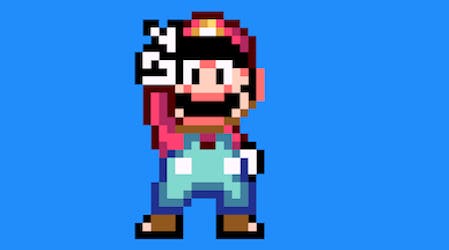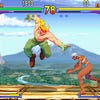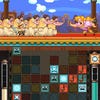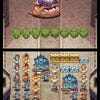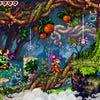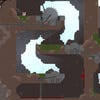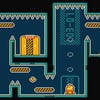Pixel Art: The End of an Era?
Top developers take the pulse of the art form that defined gaming.
At a glance, the release of Kirby Mass Attack late last month was an inauspicious event. The umpteenth title in a series that has never really taken flight in Europe on a system recently put out to pasture, it huffed and puffed into the UK DS chart at number 30, just behind something called Horrid Henry's Horrid Adventure.
However, its passing could prove rather significant. With development shifting onto the more powerful 3DS, Mass Attack - with its charming, intricate, old-fashioned sprites - might be the last 2D pixel art title that Nintendo ever releases.
The humble DS is arguably the final platform where the decision to visualise a game by painstakingly filling in tiles of pixels is a pragmatic, technical necessity. With the 3DS boasting a considerable leap in horsepower over its predecessor, the only reason to develop a mainstream retail release using pixel art rather than more modern graphical techniques would be an aesthetic one.
Matt Bozon, creative director at sprite specialists WayForward Technologies, whose wonderful 16-bit throwback Aliens Infestation might similarly be among publisher Sega's final pixel art projects, suggests that while we might see a handful of such titles on the 3DS, it's not a creative path many major publishers will likely take.
"There was a decline in pixel art on the Game Boy Advance, and there was even less of it on Nintendo DS," he tells Eurogamer. "And with the games industry quickly changing into a summer blockbuster movie-making model, the pixel isn't flashy enough to feed the masses."
Nintendo wouldn't offer a definitive answer when approached for comment, but Mass Attack's director Mari Shirakawa didn't offer much cause for optimism.
"The display resolution of hardware will certainly continue to improve and, as you say, the necessity of pixel art will most likely diminish," she explains.
"I think pixel art has a unique artistic charm that you can't find in polygon art and it is personally one of my favourite graphic styles, so it would indeed be sad to see pixel art being used less and less frequently.
"At the same time, I don't necessarily see this as a major loss since improved graphic display will help to expand the possibilities of games."
Along with Wayforward, Toronto-based Capybara Games is one of the few other Western studios still priding itself on its pixel art. The original DS version of this year's sublime puzzle RPG Might & Magic: Clash of Heroes sported some of the most skilful, charismatic sprite work since the 16-bit golden age. Capybara agrees that times are changing.
"On prior handhelds up to the PSP, the screen resolution was small enough that pixels were often the best choice for clarity," explains co-founder and lead artist Anthony Chan.
"As we move out of 'small screen devices', that limitation goes away. Many of the supremely talented pixel artists may migrate to doing HD 2D art instead - you can see this here at Capy, as well as with other studios like WayForward."
"So what?" you may ask. Well, for the generation whose formative gaming years came before the PS1 and N64 ushered in the 3D age, it would truly represent the end of an era. Iconic, reassuring and wonderfully expressive despite its simplicity, for many, pixel art is gaming. It's a cold-hearted, jaded gamer who doesn't feel a warm glow at the sight of a blocky Mega Man sprite leaping through the air or a 16-bit Link triumphantly hoisting a piece of the Triforce above his head.
"It would be sad [to see it go] because pixel art is intertwined with games. It's part of the fabric, part of its history," says Chan.
"It would be like forgetting there was hand drawn animation, as the film industry seems to have done. You have to know where things came from, see the evolution, and appreciate the ability to 'modernise' techniques that may not be modern themselves."
However, Adam Saltsman, creator of iOS pixel art free-runner Canabalt, argues that its appeal goes beyond just pure nostalgia. Its purity, precision and clarity have myriad benefits when it comes to crafting engaging gameplay. He argues that the rigid predictability of pixel-by-pixel animation is much easier for the player to process and respond to than more modern techniques.
"You can see it in Street Fighter 4 versus Street Fighter 3," he explains.
"Even though Street Fighter 3 is in many ways a faster, more aggressive game, and in some ways a less accessible game, the fact that the animation is discretised and quantised makes it a lot easier to learn timings and understand what sort of things are going on.
"Your brain goes, 'Oh, when the animation is frozen in this pose, I press this button and that's the right timing.' While in Street Fighter 4 it's more like 'Once the leg starts to move off the ground and it's moved part way through this animation then I press whatever button'. You don't have a concrete signpost for training yourself.
"For timing-based games, for learning from interactive game systems, the fact that there is a style or language for quantised motion helps people learn and it's a really useful thing."
Chan adds that by asking the player to fill in a few blanks, the simplicity of pixel art also helps engage a participant in the game and fire the imagination in a way that more literal visual styles just don't have the power to do.
"On a conceptual level, the representational aspect of pixel art is both rewarding and challenging," he insists.
"Drawing a circle with two dots and a line is a representation of a face - it lets the player fill in the abstraction, interacting with the game in a visual sense as well as a 'mechanics' sense."
Above and beyond that, he argues, its abstract, precise nature helps maintain the fourth wall, whereas the quest for perfect photorealism in modern 3D visuals can highlight small-but-jarring imperfections that rip the player out of the experience.
"Pixel art lacks the distraction of 3D," Chan explains.
"The more real you get with 3D the more flaws you see in the assets - this happens far before the uncanny valley, but it is also greatly accentuated by it. With 3D emulating the real world, the player can easily mistake a game for being real, making issues with texturing, animation and even technical components like collision far more obvious."
Perhaps most importantly though, pixel art levels the playing field. You don't need huge budgets, massive teams, pricey tech and an expensive education to make a pixel art game. You just need passion, elbow grease and some artistic flair.
"There are few barriers to entry, results come quickly and it's possible to reach a professional standard much more easily than competing with a five star modern console game," reckons Wayforward's Bozon.
And it's this inherent efficiency that's helping keep the medium alive. While mainstream publishers might be moving on, indie developers have picked up the torch, fuelled both by nostalgia for the games of their youth and the fact that it's an affordable, accessible way to make stylish video games.
Digital delivery systems like the App Store, Steam and XBLA have liberated developers to make the kind of games they want to play - not what Activision or EA's mainstream agenda dictates. Duly, they've found there's a very receptive audience out there.
Saltsman's aforementioned Canabalt, lovely iOS puzzler The Last Rocket, brutal retrograde jumper VVVVVV, Wayforward DSiWare gems like Shantae: Risky's Revenge and Mighty Flip Champs, Super Meat Boy, Superbrothers: Sword & Sworcery, Cave Story, Tiny Tower, Game Dev Story, the Bit.Trip series, Capy's forthcoming Super T.I.M.E. Force... the list of fantastic - not to mention commercially successful - pixel-based indie titles goes on.
The small handful of developers still working with pixel art today do so because they want to, not because they have to. Unlike those working in 3D, they're not restricted by the need to nudge up poly counts, increase texture size and generally push the technical envelope. Pixel art is a medium that's much further along its own evolutionary path and as a result, designers can concentrate solely on making something truly distinctive, both from a visual and gameplay perspective.
"Remember the last 75 years of practical effects being the only form of special effects in film?" asks Bozon.
"Latex puppets and miniature sets were the only path until CG game along. Well, people are still entertaining the masses with puppetry, only now it's by choice.
"It's the same with pixel art. Creative people can work above the technology and set limits for themselves to create something that looks unique. So, you could say we're past the golden age of pixels, but are now free to use them purely for self-expression."
The one concern is the size of the potential market. Can it grow beyond grey-haired gamers ensnared by the promise of a return to simpler times? Is the sight of a primitive cluster of pixels a turn-off for the teen and pre-teen market - the generation raised on Halo and Call of Duty rather than Pac-Man and Gradius? Saltsman isn't too concerned.
"We used to wonder whether if you put old pixelated games in front of kids would they just basically barf because the game is so ugly compared to Super Mario Galaxy or whatever," he explains.
"My nephew might be slightly too old - he's seven or eight - but when he comes over he really loves to put on all the weird old super-pixelated games on my NES or Mega Drive. It's not the art that's a problem, it's the insane difficulty of the games. That's the part that shuts him down.
"My Mum can play pixel art games, kids can play them - I don't really think there's anything about it that's a problem," he continues.
"I'm just eager to move past the... you know when someone links you to that picture of Dino Riders and they're like 'Woah, dude, the '80s!', and that's the whole joke, the whole comment. I feel like we're so close to being out of that with pixel art, which would be really nice. I think that's been kind of an awkward phase and instead it will just be a useful tool which we can employ for communication sometimes."
For better or worse, in 2011, most AAA developers take their visual cues from Michael Bay, Spielberg or Pixar, striving to produce video games that look as little like video games as possible. While it's a little sad that it's left to resourceful indies to honour the pioneering work of the form's creative forefathers, it's great to see the likes of Capy, Wayforward and Saltsman step up to preserve - and innovate on - the one visual medium that the games industry can truly call its own.
"It's burned into pop culture, so I don't think it can truly go away," concludes Bozon.
"Techniques will get lost over time, but visionary styles will most likely stick. As a creative exercise, try to imagine a future where polygonal graphics are no longer the norm. Games that had cool visual styles will stick with us, but ones that were trying to achieve reality might not age well and look awkward. Hopefully, we can keep on using technology in new and artful ways."
